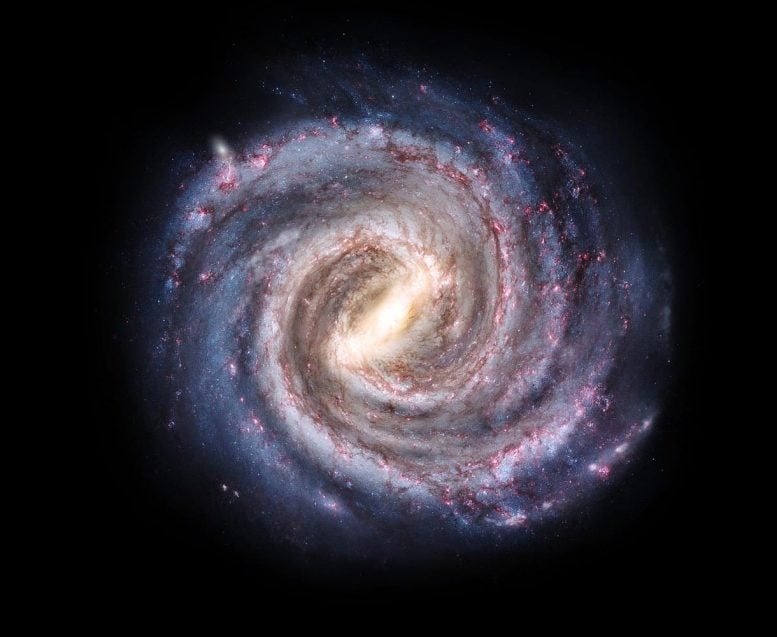
“Maggie,” a massive hydrogen filament found in the Milky Way, offers new insights into molecular cloud formation and star development. Credit: Pablo Carlos Budassi
A research team has identified a significant hydrogen gas filament, “Maggie,” extending 3,900 light-years in our galaxy. The findings from the THOR survey suggest that Maggie plays a crucial role in the transition of atomic to molecular hydrogen, which is vital for star formation.
Our Universe began some 13.8 billion years ago in a huge explosion that produced the first subatomic particles and the laws of physics as we know them today. The star’s basic material, hydrogen, had created around 370,000 years later. Stars fuse hydrogen and helium inside of them to generate all the heavier elements. While hydrogen remains the most pervasive element in the Universe, it can be difficult to detect individual clouds of hydrogen gas in the interstellar medium (ISM).
Discovery of the “Maggie” Filament
This makes it difficult to research the early phases of star formation, which would offer clues about the evolution of galaxies and the cosmos. An international research team led by astronomers from the Max Planck Institute of Astronomy (MPIA) recently noticed a massive filament of atomic hydrogen gas in our galaxy. This structure, named “Maggie,” is located about 55,000 light-years away (on the other side of the Milky Way) and is one of the longest structures ever observed in our galaxy.
The study that describes their findings, which was published recently in the journal Astronomy & Astrophysics, was led by Jonas Syed, a Ph.D. student at the MPIA. He was joined by researchers from the University of Vienna, the Harvard-Smithsonian Center for Astrophysics (CfA), the Max Planck Institute for Radio Astronomy (MPIFR), the University of Calgary, the Universität Heidelberg, the Centre for Astrophysics and Planetary Science, the Argelander-Institute for Astronomy, the Indian Institute of Science, and NASA’s Jet Propulsion Laboratory (JPL).
Exploring the Formation of Molecular Clouds
The research is based on data obtained by the HI/OH/Recombination line survey of the Milky Way (THOR), an observation program that relies on the Karl G. Jansky Very Large Array (VLA) in New Mexico. Using the VLA’s centimeter-wave radio dishes, this project studies molecular cloud formation, the conversion of atomic to molecular hydrogen, the galaxy’s magnetic field, and other questions related to the ISM and star formation.
The ultimate purpose is to determine how the two most-common hydrogen isotopes converge to create dense clouds that rise to new stars. The isotopes include atomic hydrogen (H), composed of one proton, one electron, and no neutrons, and molecular hydrogen (H2) is composed of two hydrogen atoms held together by a covalent bond. Only the latter condenses into relatively compact clouds that will develop frosty regions where new stars eventually emerge.

This image shows a section of the side view of the Milky Way as measured by ESA’s Gaia satellite. The dark band consists of gas and dust, which dims the light from the embedded stars. The Galactic Centre of the Milky Way is indicated on the right of the image, shining brightly below the dark zone. The box to the left of the middle marks the location of the “Maggie” filament. It shows the distribution of atomic hydrogen. The colors indicate different velocities of the gas. Credit: ESA/Gaia/DPAC, CC BY-SA 3.0 IGO & T. Müller/J. Syed/MPIA
The Significance of Maggie’s Length and Location
The process of how atomic hydrogen transitions to molecular hydrogen is still largely unknown, which made this extraordinarily long filament an especially exciting find. Whereas the largest known clouds of molecular gas typically measure around 800 light-years in length, Maggie measures 3,900 light-years long and 130 light-years wide. As Syed explained in a recent MPIA press release:
“The location of this filament has contributed to this success. We don’t yet know exactly how it got there. But the filament extends about 1600 light-years below the Milky Way plane. The observations also allowed us to determine the velocity of the hydrogen gas. This allowed us to show that the velocities along the filament barely differ.”
Understanding Velocity and Structure in Space
The team’s analysis showed that matter in the filament had a mean velocity of 54 km/s-1, which they determined mainly by measuring it against the rotation of the Milky Way disk. This meant that radiation at a wavelength of 21 cm (aka. the “hydrogen line“) was visible against the cosmic background, making the structure discernible. “The observations also allowed us to determine the velocity of the hydrogen gas,” said Henrik Beuther, the head of THOR and a co-author on the study. “This allowed us to show that the velocities along the filament barely differ.”

This false-color image shows the distribution of atomic hydrogen measured at a wavelength of 21 cm. The red dashed line traces the “Maggie” filament. Credit: J. Syed/MPIA
Future Research and Technological Advances
From this, the researchers concluded that Maggie is a coherent structure. These findings confirmed observations made a year before by Juan D. Soler, an astrophysicist with the University of Vienna and co-author on the paper. When he observed the filament, he named it after the longest river in his native Colombia: the Río Magdalena (Anglicized: Margaret, or “Maggie”). While Maggie was recognizable in Soler’s earlier evaluation of the THOR data, only the current study proves beyond a doubt that it is a coherent structure.
Based on previously published data, the team also estimated that Maggie contains 8% molecular hydrogen by a mass fraction. On closer inspection, the team noticed that the gas converges at various points along the filament, which led them to conclude that the hydrogen gas accumulates into large clouds at those locations. They further speculate that atomic gas will gradually condense into a molecular form in those environments.
“However, many questions remain unanswered,” Syed added. “Additional data, which we hope will give us more clues about the fraction of molecular gas, are already waiting to be analyzed.” Fortunately, several space-based and ground-based observatories will become operational soon, telescopes that will be equipped to study these filaments in the future. These include the James Webb Space Telescope (JWST) and radio surveys like the Square Kilometer Array (SKA), which will allow us to view the very earliest period of the Universe (“Cosmic Dawn“) and the first stars in our Universe.
Adapted from an article originally published on Universe Today.
For more on this research, see Massive Filament Structure – 3900 Light-Years Long – Discovered in the Milky Way.
Reference: “The “Maggie” filament: Physical properties of a giant atomic cloud” by J. Syed, J. D. Soler, H. Beuther, Y. Wang, S. Suri, J. D. Henshaw, M. Riener, S. Bialy, S. Rezaei Kh., J. M. Stil, P. F. Goldsmith, M. R. Rugel, S. C. O. Glover, R. S. Klessen, J. Kerp, J. S. Urquhart, J. Ott, N. Roy, N. Schneider, R. J. Smith, S. N. Longmore and H. Linz, 20 December 2021, Astronomy & Astrophysics.
DOI: 10.1051/0004-6361/202141265









Be the first to comment on "Astronomers Find the Biggest Structure in the Milky Way: Filament of Hydrogen 3,900 Light-Years Long"